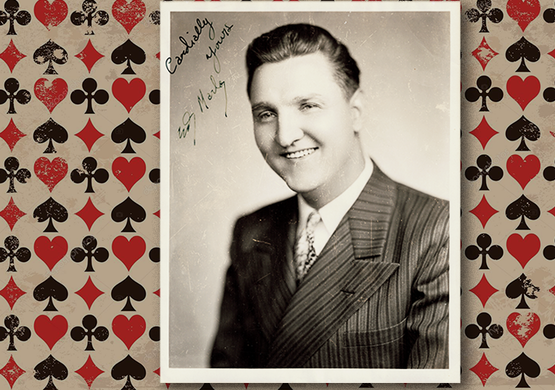If I was presented with a one-time opportunity to take a time machine trip to another period in magic, tempting as it might be to go to the turn of the 20th century and see the great stage performers of England, or the great world traveling illusion shows of the so-called Golden Age of Magic, or the famed stars of vaudeville like Cardini and Harry Houdini, if I had to choose a particular magic era, it would the “Night Club Era” that was born in the 1920s, fueled by Prohibition, and barreled toward its peak in the aftermath of vaudeville. As the great vaudeville houses were converted to movie theaters, and only the well-to-do could go out to shows in the aftermath of the Great Depression, the best hotels in big cities across the country opened nightclub rooms where live bands performed, patrons could dress up and dance, and a mini-vaudeville program could include singers, comics, and variety acts like magicians. The Night Club Era drew a straight line from the Roaring Twenties, through the Depression, through Vaudeville, finally reaching its apex in the rise of Las Vegas as a center for live entertainment.
The kind of magic that was seen in these high-end hotel clubs was the same kind of magic we feature at Monday Night Magic. (I am one of the four producers, along with Michael Chaut, Peter Samelson, and Todd Robbins; the show is now New York City’s longest-running Off-Broadway show, in our 19th continuous season.) Our mix of four acts on stage ever week—EmCee, opener, middle, and headliner—represent a blend of silent and talking acts (mostly magic but with other occasional variety performers), that by and large rely on small props, clever talk, and memorable personalities—the very same kind of performances that were featured in those grand night clubs. I would give anything to have seen Paul Rosini, a nightclub star in the ‘40s and ‘50s, who could work a week in a hotel club, entertaining repeat patrons by varying his program night after night with a blend of card tricks and classics like the Linking Rings, the Egg Bag, the Card in Cigarette, the Miser’s Dream, and the Blindfold Card Stab (and I suppose I probably would like to have seen Max Malini, the originator of this last routine, more than any other performer in all of magic’s history).
One of the last of the great nightclub magicians was Roy Benson, who was a headliner in the ‘40s and ‘50s, playing clubs including the Latin Quarter in New York, the Empire Room in Chicago, the Casino Nationale in Havana, and the Golden Gate Theatre, in San Francisco. Benson was a profoundly influential magician. His stage and nightclub work was focused on comedy, combining a sly, offbeat sense of humor with an air of playful if deadpan repartee. But the light comic touch belied a deep current of magical talent, including innovative creations that influenced countless other performers of his own time and later, and monster sleight-of-hand chops. And he was also a creative and expert close-up performer, whose signature trick, the Benson Bowl Routine, became trademarks of legendary pros like Don Alan, Al Goshman, Johnny Thompson and more.
Benson was a teenaged protégé of the vaudeville legend, Nate Leipzig, taking the lessons he drew from that great sleight-of-hand artist and turning them to more humorous purpose. Benson was at the cutting edge both magically and comedically; in one routine he would lie down across the edge of the stage and talk to the audience as if he was on the couch speaking to his psychiatrist, while the odd magic effect unfolded in his hands. He was not only hilariously funny, but his ironic, self-deprecating take on magic was decades ahead of its time.
I haven’t the space to do justice to Benson’s life and accomplishments (he was also a musician, a movie actor, and he appeared on The Ed Sullvian Show 24 times, more than any other magician). The complete Roy Benson biography can be found in Roy Benson by Starlight by Todd Karr and Levent (The Miracle Factory, 2006), in which my friend Levent—a top pro in his own right who follows in Benson’s footsteps as a comic performer with tremendous sleight-of-hand skills—reconstructs and recounts the workings and lessons of Benson’s magic in extraordinary detail. (The book is out of print but copies can be found for under $200, a worthy investment for any serious magic student.)
But this brief overview of one of the greatest magical performers and innovators of the 20th century should, I hope, serve to encourage you to bring your close attention and appreciation to these two film clips. They are black-and-white, they are of less than stellar quality, they are of another era … but no recorded version ever does full justice to magic, so it is up to you, like any audience, to invest yourself in the performance, and that investment will be returned to you by the performer (even if it is from beyond the grave). Expand the browser, turn up the volume, and enjoy the truly great, truly inimitable, Roy Benson.
This recording reflects the core of Benson’s act. He had much more material than this, but the act was build on this core structure: a quick opener, then his classic version of the Chinese Sticks, and closing with his original creation, the “long pour” ending for the ancient Salt Trick. Enjoy …
This recording, of poorer quality, repeats some of the same material, but this version closes on a Benson trademark: the Billiard Balls. This is truly beautiful magic, which also happens to be staggeringly difficult. We’ve skipped the duplicate material and rough spots to start you right at the billiard ball routine at 4:30 in. Be amazed!
MORE: TAKE TWO ARCHIVE



